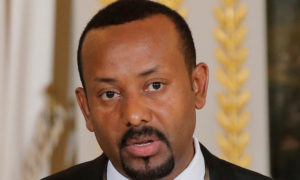
Israeli model May Tager, holding an Israeli flag, poses with Dubai-resident model Anastasia Bandarenka, holding an Emirati flag, during a photo shoot for FIX’s Princess Collection, in Dubai, United Arab Emirates, Sept. 8, 2020. Photo: Reuters / Christopher Pike.
JNS.org – Prime Minister Benjamin Netanyahu’s visit to Saudi Arabia last week and his meeting with Saudi Crown Prince Mohammed bin Salman made headlines worldwide, but it is safe to assume that the meeting was not the first of its kind. It has previously been hinted that Israeli officials of various levels have visited the Gulf kingdom, and it was also reported that the prince had visited Israel.
As is the case with regard to the United Arab Emirates and Bahrain, Israel’s relations with Saudi Arabia are based on common interests, and are less about mutual affection and more about mutual aversion to a common adversary. It isn’t farfetched to assume that Iran was the focus of the talks between the two leaders.
Both Jerusalem and Riyadh are troubled by President-elect Joe Biden’s stated intention to rejoin the 2015 Joint Comprehensive Plan of Action nuclear deal with Iran, which President Donald Trump exited in 2018.
The concern is that just as the heavy sanctions imposed on Iran have brought it to its knees, the regime will again be allowed to rear its head and not only rehabilitate its devastated economy, but also accelerate its military buildup and the scope of the support it provides to its proxies in Yemen, Iraq, Syria, Lebanon, and the Gaza Strip.
Related coverage

November 30, 2020 7:24 am
In terms of the moderate axis in the region, which Israel and Saudi Arabia are leading, this is the stuff of nightmares. The Abraham Accords have created a Middle East in which the “good guys” and the “bad guy” stand distinctly apart: The Iranian “Shiite crescent,” which begins in Yemen and ends on the shores of the Mediterranean, is now offset by a moderate axis that stretches from the Persian Gulf to Israel and farther to the northwest.
It seems that this axis, to which the Gulf states are partners, now seeks to present a united front vis-à-vis the new administration in Washington in an attempt to use whatever leverage it can with respect to the Iranian issue.
The primary preference of the moderate axis is to keep Iran in economic ruins and under heavy sanctions. The more realistic approach, however, is to spare no effort to influence Washington to reach a better nuclear deal than the one from which the US withdrew under the Trump administration.
Over the past few months, Iran has been slowly and carefully advancing its nuclear program, and has already recorded six notable violations of the JCPOA. Naturally, Iran vehemently opposes any restrictions and will only conditionally undertake to uphold its commitments under the JCPOA. However, Tehran’s financial distress is acute, and it will likely do anything to breathe life back into its moribund economy.
The stakes are high and are likely to affect Iran’s decision on whether to attempt to exact revenge on the upcoming first anniversary of the assassination by the United States of Gen. Qassem Soleimani, the infamous commander of Iran’s notorious extraterritorial black-ops arm, the Quds Force.
Seemingly, the date — January 3 — is ideal: Washington will be gearing up for the presidential inauguration on January 20, the transition of the administration will be in full swing, Trump will be unable to retaliate, and Biden’s hands will be equally tied.
Still, this would be too adventurous for Tehran, and the timing is actually less desirable than it seems, not only because of Iran’s desire to return to the nuclear deal, but also because the Islamic Republic itself is gearing up for a presidential election in May, and outgoing President Hassan Rouhani will do everything he can to leave a conciliatory legacy, with the nuclear deal as its main highlight.
But Iran cannot let the first anniversary of Soleimani’s assassination simply go by, and may choose to act against Israel, as retribution by proxy. The IDF remains on high alert in the northern sector, where Iran has Hezbollah in Lebanon and IRGC forces in Syria at its disposal.
Israel is taking this threat very seriously and it has already utilized every back channel to send a clear message to every actor in the region, warning that the Israeli reaction to any attack will be utterly disproportionate.
Alongside Iran, this message is meant mostly for Syrian President Bashar al-Assad, who has already demanded Iran roll back its activities on Syrian soil so as not to undermine his interests.
At the time, Tehran agreed, but that is no longer the case. Assad is financially and psychologically dependent on the ayatollahs for his survival and as Iran was the first to rally to his aid when the Syrian civil war erupted in 2011, he will have to receive a substantial incentive to truly try to shake off the Iranian bear hug.
What Assad really wants is for the United States to lift the sanctions on Syria and give up its demand that any such move will only follow his removal from power.
This is an ostensibly immoral move: Assad is a mass murderer and a senior accomplice in the axis of evil. There is no reason to show him any leniency. But the reality is more complicated, and in the fabric of Middle East interests now being woven, it may be possible to back a regional move that would include the removal of US sanctions, followed by extensive investments by Gulf states that would allow Syria to recover and remove, by agreement, foreign forces — American and Iranian.
It is doubtful whether such a deal was possible in the past, but as has been proven many times recently, ideology in the area is dead and only interests remain.
Given a choice between Iran and the big money — when Russia, Assad’s other key ally, clearly sides with money — the Syrian president will have a hard time choosing to remain poor and under threat.
Syria is not the only one at a crossroads: Qatar also wants to turn a new leaf in its relations with the West and its Gulf frenemies, and Iraq is also wary of completely falling for Iran’s charms, preserving its interests vis-à-vis the Americans and the West. This will all affect Israeli-Arab relations moving forward.
Yoav Limor is a veteran Israeli journalist and columnist for Israel Hayom. This article first appeared in Israel Hayom.
Related posts:
Views: 0
 RSS Feed
RSS Feed

















 November 30th, 2020
November 30th, 2020  Awake Goy
Awake Goy  Posted in
Posted in  Tags:
Tags: 
















